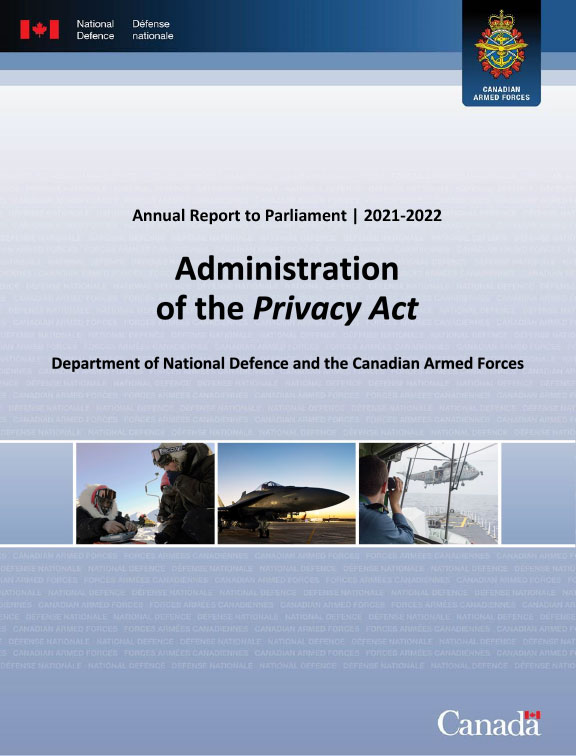2021-2022 Annual Report to Parliament - Administration of the Privacy Act
Department of National Defence and the Canadian Armed Forces
On this page
- Introduction
- Access to Information and Privacy at National Defence
- Highlights of the Statistical report
- COVID-19 Impacts to Privacy Operations
- Privacy protection and personal information management
- Complaints, audits and reviews
- Policies and procedures
- Training and Awareness
- Initiatives and projects
- Monitoring compliance
- Privacy operating costs
1. Introduction
The Department of National Defence and the Canadian Armed Forces are pleased to present to Parliament their annual report on the administration of the Privacy Act. Section 72 of the Act requires the head of every federal government institution to submit an annual report to Parliament on its administration each financial year. This report describes National Defence activities that support compliance with the Privacy Act for the fiscal year (FY) commencing 1 April 2021 and ending 31 March 2022.
1.1 Purpose of the Privacy Act
The purpose of the Privacy Act is to extend the present laws of Canada that protect the privacy of individuals with respect to personal information about themselves held by a government institution and provide individuals with a right of access to that information.
These rights of protection and access are in accordance with the principles that individuals should have a right to know why their information is collected by the government, how it will be used, how long it will be kept and who will have access to it.
Service Agreements
The Department of National Defence and the Canadian Armed Forces had no service agreements pursuant to section 73.1 of the Privacy Act.
2. Access to Information and Privacy at National Defence
2.1 Mandate of National Defence
Who we are
The Department of National Defence (DND) and the Canadian Armed Forces (CAF) make up the largest federal government department. Under Canada’s defence policy, the Defence Team will grow to over 125,000 personnel, including 71,500 Regular Force members, 30,000 Reserve Force members and 25,000 civilian employees.
What we do
DND and the CAF have complementary roles to play in providing advice and support to the Minister of National Defence, and implementing Government decisions regarding the defence of Canadian interests at home and abroad.
At any given time, the Government of Canada can call upon the CAF to undertake missions for the protection of Canada and Canadians and to maintain international peace and stability.
Canada’s defence policy presents a strategic vision for defence: Strong, Secure, Engaged. This is a vision in which Canada is:
Strong at home, with a military ready and able to defend its sovereignty, and to assist in times of natural disaster, support search and rescue, or respond to other emergencies.
Secure in North America, active in a renewed defence partnership in the North American Aerospace Defense Command (NORAD) and with the United States to monitor and defend continental airspace and ocean areas.
Engaged in the world, with the Canadian Armed Forces doing its part in Canada’s contributions to a more stable, peaceful world, including through peace support operations and peacekeeping.
The National Defence Act (NDA) establishes DND and the CAF as separate entities, operating within an integrated National Defence Headquarters as they pursue their primary responsibility of providing defence for Canada and Canadians.
2.2 National Defence Organization
Senior leadership
The Governor General of Canada is the Commander-in-Chief of Canada. DND is headed by the Minister of National Defence. The Associate Minister of National Defence supports the Minister of National Defence. The Deputy Minister of National Defence is the Department’s senior civil servant. The CAF are headed by the Chief of the Defence Staff, Canada’s senior serving officer. These senior leaders each have different responsibilities:
- The Governor General is responsible for appointing the Chief of the Defence Staff on the recommendation of the Prime Minister, awarding military honours, presenting colours to CAF regiments, approving new military badges and insignia, and signing commission scrolls;
- The Minister of National Defence presides over the Department and over all matters relating to national defence;
- The Associate Minister is also responsible for defence files, as mandated by the Prime Minister, with the specific priority of ensuring that CAF members have the equipment they need to do their jobs;
- The Deputy Minister is responsible for policy, resources, interdepartmental coordination and international defence relations; and
- The Chief of the Defence Staff is responsible for command, control and administration of the CAF, as well as military strategy, plans and requirements.
Defence organization
The National Defence organizational structure is represented in the diagram below. Additional information about the National Defence organization is available online.
Figure 1: National Defence Organization Chart
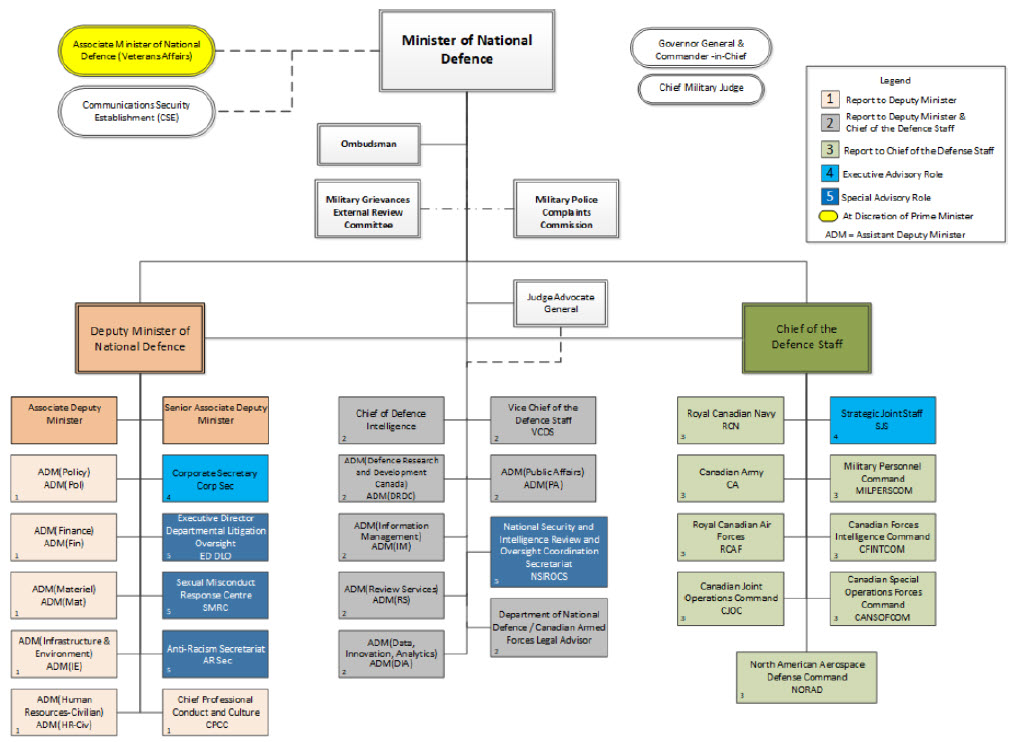
2.3 The Directorate of Access to Information and Privacy
Delegation of Authority
In accordance with section 73(1) of the Privacy Act, a delegation of authority, signed by the Minister, designates the Deputy Minister, Corporate Secretary, Executive Director of Access to Information and Privacy, Access to Information Chief of Operations, and Access to Information and Privacy (ATIP) Deputy Directors to exercise all powers and functions of the Minister, as the head of institution under the Act. It also designates other specific powers and functions to employees within the Directorate Access to Information and Privacy.
Under the authority of the Corporate Secretary, the ATIP Executive Director administers and coordinates the Access to Information Act and the Privacy Act, and acts as the departmental ATIP Coordinator. In the administration of the Act, the ATIP Directorate seeks advice on legal, public affairs, policy, and operational security matters from other organizations and specialists as required.
A copy of the Access to Information Act and Privacy Act Designation Order is provided at Annex A.
The ATIP Directorate
The ATIP Directorate is responsible for matters regarding access to information and privacy protection within the National Defence portfolio, excepting the following organizations: the Military Police Complaints Commission, the Military Grievances External Review Committee, the Communications Security Establishment, the Office of the National Defence and Canadian Forces Ombudsman, the Office of the Chief Military Judge and the Director of Defence Counsel Services, and the Canadian Forces Morale and Welfare Services.
The Directorate’s ATIP program management workforce is divided functionally into four main areas, and supported by Defence organization liaison officers, as illustrated in the diagram at Figure 2.
Figure 2: National Defence ATIP Operational Workforce
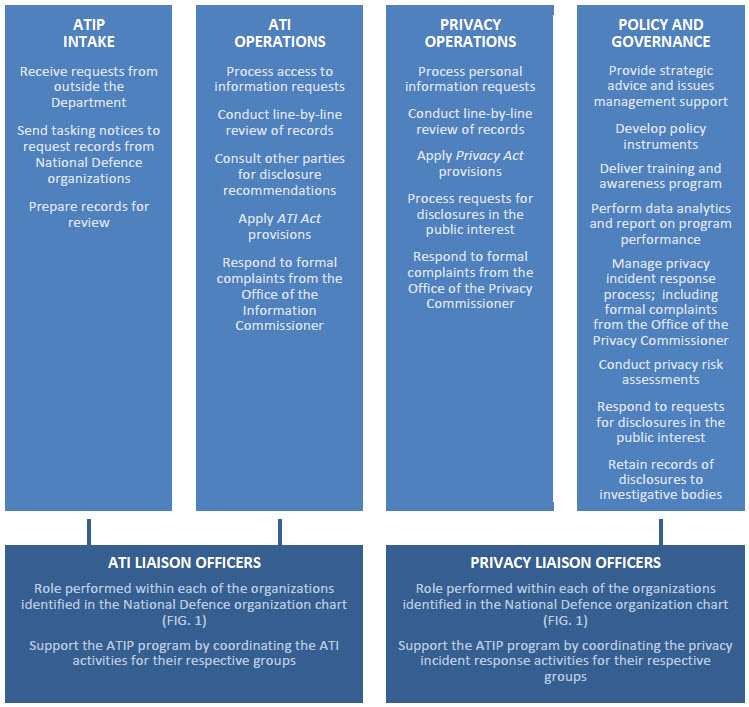
Long description
ATIP Intake receive requests from outside of the Department, send tasking notices to request records from National Defence organizations and prepare records for review.
ATI Operations process access to information requests, conduct line-by-line review of records, consult other parties for disclosure recommendations and apply Access to Information Act provisions, respond to formal complaints from the Office of the Information Commissioner.
ATI Liaison Officers is a role performed within each of the organizations identified in the National Defence organization chart. This role supports the ATIP program by coordinating the ATI activities for their respective groups.
Privacy Operations process personal information requests, conduct line-by-line review of records, apply Privacy Act provisions, process requests for disclosures in the public interest, and respond to formal complaints from the Office of the Privacy Commissioner.
Policy and Governance provides strategic advice and issues management support, develop policy instruments, deliver training and awareness program, perform data analytics and report on program performance, manage privacy incident response process, conduct privacy risk assessments, respond to requests for disclosures in the public interest and retain records of disclosures to investigative bodies.
The Privacy Liaison Officers is a role performed within each of the organizations identified in the National Defence organization chart. This role supports the ATIP program by coordinating the privacy incident response activities for their respective groups.
The ATIP Directorate is managed by an Executive Director and supported by a Chief of Operations that oversees all aspects of ATI operations, including intake; and Deputy Directors overseeing Privacy Operations and the Policy and Governance Team.
The Chief of Operations oversees all activities related to access to information. This ensures consistency in the execution of departmental processes and application of the ATI Act and allows for quality assurance activities, tracking, reporting, and monitoring of trends and rising issues.
The ATIP Directorate is supported by a systems liaison team that maintains the ATIP application system/database and provide technical support to members of the team, and a corporate services team that is responsible for the completion of administrative and management functions of the directorate, including business planning, financial management, human resources, physical security, and information and records management (IM/RM).
In addition to access to information and privacy protection activities, the ATIP Directorate provides a supporting role to the Departmental Litigation Oversight-Litigation Implementation Team. The Directorate performs an ATIP-like review of records in support of class action settlements when required.
3. Highlights of the Statistical report
The statistical report at Annex B consists of data submitted by National Defence as part of Treasury Board Secretariat (TBS) annual collection of ATIP-related statistics. The following sections contain highlights, trends and an analysis of notable statistical data from a departmental perspective.
3.1 Requests received
During the reporting period, National Defence received 6,158 requests for personal information under the Privacy Act versus 5,275 in FY 2020-21, representing a 16.7% increase. This increase is notable after the previous four consecutive years of decreased requests for personal information. Current FY requests, combined with 1,224 files carried over from the previous reporting period equates to a total workload of 7,382 requests.
Figure 3: Privacy Request Workload (Last Five Years)

Long description
In 2017-2018, 7393 requests were received, 2659 requests were carried over from the previous reporting period. A combined workload of 10,052 requests.
In 2018-2019, 6637 requests were received, 4183 requests were carried over from the previous reporting period. A combined workload of 10,820 requests.
In 2019-2020, 6475 requests were received, 1814 requests were carried over from the previous reporting period. A combined workload of 8,289 requests.
In 2020-2021, 5275 requests were received, 853 requests were carried over from the previous reporting period. A combined workload of 6128 requests.
In 2021-2022, 6158 requests were received, 1224 requests were carried over from the previous reporting period. A combined workload of 7382 requests.
3.2 Requests completed
National Defence closed a total of 6,567 privacy requests during the reporting period. This represents a 34% increase over the previous FY. The total ATIP workload over the past five years is represented in Figure 4 below.
Figure 4: Disposition of requests completed and total requests closed (Last five years)
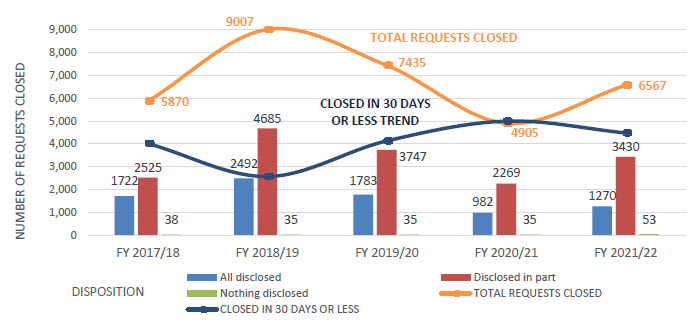
Long description
In 2017-2018, 1722 were all disclosed, 2525 were disclosed in part, 39 where nothing was disclosed, 1223 where no records exist, and 362 were abandoned. A total of 5871 requests were closed.
In 2018-2019, 2492 requests were all disclosed, 4685 requests were disclosed in part, and 35 requests where nothing was disclosed, 1301 requests where no records exist, and 493 requests were abandoned. A total of 9006 requests were closed.
In 2019-2020, 1783 requests were all disclosed, 3747 requests were disclosed in part, and 36 where nothing was disclosed, 1369 requests where no records exist, 501 requests were abandoned. A total of 7436 requests were closed.
In 2020-2021, 982 requests were all disclosed, 2269 were disclosed in part, and 35 requests where nothing was disclosed, 1211 requests where no records exist, 407 were abandoned. A total of 4904 were closed.
In 2021-2022, 1270 requests were all disclosed, 3430 were disclosed in part, and 53 requests where nothing was disclosed, 1311 requests where no records exist, 503 were abandoned. A total of 6567 were closed.
Pages reviewed
This year, a total of 1,579,710 pages were reviewed to close 5,256 requests. This represents a 50.4% increase in pages processed from FY 2020-21. (Figure 5).
This number does not include the number of pages processed for requests reviewed in the current FY that were carried over into the next reporting period.
Figure 5: Number of pages reviewed for requests closed, where records existed (Last three years)

Long description
In 2019-2020, 2,381,632 pages reviewed for 6067 requests closed
In 2020-2021, 1,050,542 pages reviewed for 3693 requests closed
In 2021-2022, 1,579,710 pages reviewed for 5256 requests closed
Exemptions and exclusions
Consistent with previous reporting periods, section 26 of the Privacy Act was the most frequently invoked exemption and was applied in 3,408 requests. This section of the Act protects personal information of individuals other than the requester.
Completion time
National Defence closed 4,482 requests within 30 days; this represents 68.3% of the total volume of requests closed. This equates to an 8.7% increase of files closed within 30 days, compared to 2925 files closed within 30 days during the last reporting period. Of note, the number of files closed in excess of 121 days decreased significantly from 988 files in FY 2020-21 to 705 during this reporting period.
Figure 6: Time to complete requests (Last five years)
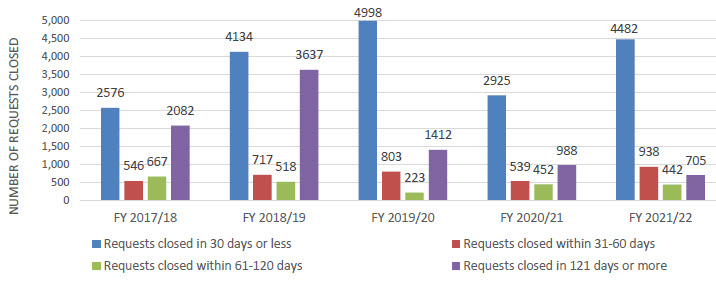
Long description
In 2017-2018, 2576 requests were closed in 30 days or less, 546 requests were closed between 31-60 days, 667 requests were closed between 61-120 days and, 2052 requests were closed in 121 days or more
In 2018-2019, 4134 requests were closed in 30 days or less, 717 requests were closed between 31-60 days, 518 requests were closed between 61-120 days and, 3637 requests were closed in 121 days or more
In 2019-2020, 4998 requests were closed in 30 days or less, 803 requests were closed between 31-60 days, 223 requests were closed between 61-120 days, and 1412 requests were closed in 121 days or more
In 2020-2021, 2925 requests were closed in 30 days or less, 539 requests were closed between 31-60 days, 452 requests were closed between 61-120 days, and 988 requests were closed in 121 days or more.
In 2021-2022, 4482 requests were closed in 30 days or less, 938 requests were closed between 31-60 days, 442 requests were closed between 61-120 days and, 705 requests were closed in 121 days or more
Files closed beyond 30 days were not necessarily late as legal extensions under the legislation may have been applied.
Extension
Section 15 of the Privacy Act permits the statutory time limits to be extended if consultations are necessary, if translation is required or if the request is for a large volume of records and processing it within the original time limit would unreasonably interfere with the operations of the Department.
In total, 993 extensions were applied during the 2021-2022 reporting period. Each of the extensions were deemed necessary as meeting the original time limit would unreasonably interfere with the operations of the institution.
Number of Active Requests - Outstanding from Previous Reporting Periods
At the end of the FY 21-22 reporting period, National Defence had 815 active requests. A breakdown of outstanding requests by the reporting period in which the request was received, and whether the request is still within the legislated timelines (including extensions) is provided below in Figure 7.
Figure 7: Number of active requests (as of 31 March 2022)
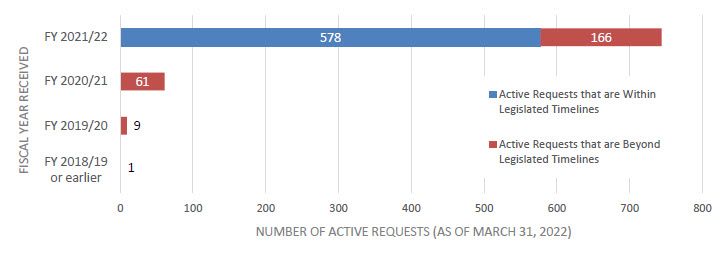
Long description
Of the requests received in 2021-22 (and active on March 31, 2022), 578 were within legislated timelines; 166 were beyond legislated timelines
Of the requests received in 2020-21 (and active on March 31, 2022), 0 were within legislated timelines; 61 were beyond legislated timelines
Of the requests received in 2019-20 (and active on March 31, 2022), 0 were within legislated timelines; 9 were beyond legislated timelines
Of the requests received in 2018-19 or earlier (and active on March 31, 2022), 0 were within legislated timelines; 1 was beyond legislated timelines
Number of Active Complaints - Outstanding from Previous Reporting Periods
At the end of the reporting period, National Defence had 34 active complaints with the Office of the Privacy Commissioner of Canada (OPC). A breakdown of active complaints by reporting period is provided at Figure 8.
Figure 8: Number of active complaints (as of 31 March 2022)
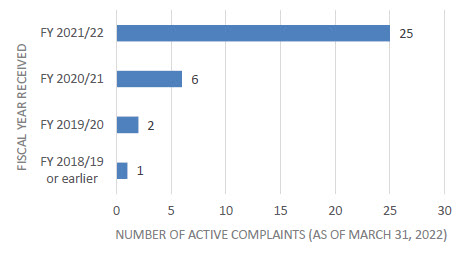
Long description
Of the complaints active on March 31, 2022:
25 complaints were received in 2021-22
6 complaints were received in 2020-21
2 complaints were received in 2019-20
1 complaints received in 2018-19 or earlier
On-time compliance
A total of 5,308 requests (80.8%) were closed within statutory deadlines in FY 2021-22. This represents a 16.4% increase in on-time compliance over the previous reporting period.
The most common reason for deemed refusal was “Interference with Operations/Workload”, cited for over 57.6% of requests closed late during the reporting period. As defined by TBS, this reason relates to requests where there is “interwoven information and review is required to determine exemptions, there were a large number of requests to be processed at the time, the request consisted of a high volume of records, there were difficulties in obtaining relevant information, or there were other ATIP-related tasks”.
Impacts to productivity resulting from staffing challenges continues to impact compliance. There continues to be ATIP staff turnover at all levels due to a competitive job market. New employees require a learning and adjustment period to realize performance potential. The hiring and training of new employees during a remote posture has also created additional workload for ATIP management and support services. Over the past year efforts have continued to staff vacant positions and train new staff.
Disposition: Percentage of requests all disclosed vs. disclosed in part
During the reporting period, Defence responded to a total of 6,567 requests. A total of 19.3% of requests were “all disclosed” (1,270) and 52.2% (3,430) of requests were “disclosed in part.” The remaining requests were completed as all exempted, no records exist, or abandoned.
Figure 9: All disclosed vs. disclosed in part (FY 2021-22)
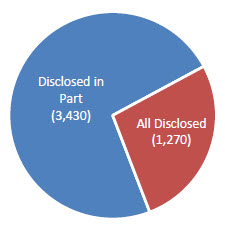
Long description
3430 requests were disclosed in part
1270 requests were all disclosed
3.3 Consultations received and completed
Historically, National Defence does not receive many consultation requests relating to requests made under the Privacy Act. During the reporting period, National Defence received five requests for consultation, all five requests for consultation were from other Government of Canada institutions. A total of six consultations were closed during the reporting period; which included one outstanding consultation request from a previous reporting period. Four requests for consultation were completed within 1-15 days; one was completed within 61-120 days; and one was completed in excess of 365 days.
4. COVID-19 impacts to privacy operations
As part of the continuing response to the COVID-19 virus, the Department of National Defence evolved from a pandemic state toward an endemic state. The ATIP office remained fully operational during FY 2021-22 reporting period; there were no significant impacts on ATIP performance attributable to COVID-19.
5. Privacy protection and personal information management
5.1 Public Interest Disclosures
Paragraph 8(2)(m) of the Privacy Act permits the disclosure of personal information, without the consent of the individual to whom it relates, where the public interest in disclosure clearly outweighs any invasion of privacy that could result, or where the disclosure would clearly benefit the individual to whom the information relates.
During the reporting period, 101 disclosures of personal information were made in accordance with paragraph 8(2)(m). Disclosures made in the public interest included but were not limited to, disclosures to the media relating to departmental actions in response to allegations of Sexual Misconduct and Hateful Conduct, and disclosures to CAF member’s family or representative relating to Boards of Inquiry or Summary Investigations into the death or serious injury of a CAF member.
For each of the 101 disclosures made in the public interest during FY 2021-22, the OPC was notified of in advance of the disclosure.
5.2 Privacy Breaches
Privacy rights are a matter of increasing public concern. In respect of sections 4 to 8 of the Privacy Act, which govern the collection, retention, use and disclosure of personal information, the ATIP Directorate received 256 complaints regarding a contravention of one or more provisions of the Act. The ATIP Directorate’s Policy & Governance Team reviewed and resolved 251 complaints alleging a breach of privacy, of which 185 complaints were deemed to be well-founded.
Material Privacy Breaches
Treasury Board Secretariat defines a material privacy breach as one that involves sensitive personal information and could reasonably be expected to cause injury or harm to the individual, and/or involves a large number of affected individuals. National Defence did not report any material privacy breach to TBS and the OPC during this reporting period.
5.3 Privacy Impact Assessments
National Defence collects, uses and discloses personal information in the delivery of mandated programs and services. In accordance with TB policy, the DND and the CAF undertake privacy impact assessments (PIA) to evaluate impacts to personal information in the administration of these activities. A PIA provides a framework to identify the extent to which proposals comply with the Privacy Act and applicable privacy policies, assist program officials in avoiding or mitigating privacy risks, and promote informed program and system design choices.
National Defence completedFootnote 1 five PIAs during FY 2021-22. The descriptions of PIAs are found below.
- Response and Support Coordination (RSC) Program - The Response and Support Coordination (RSC) Program was launched in 2019 to provide active CAF members who have experienced sexual misconduct with an assigned and dedicated Coordinator to offer on-going support and assistance.
- 1974 Valcartier Grenade Incident Program (VGIP) - The 1974 Valcartier Grenade Incident Program (VGIP) provides financial recognition and health care support for the victims of the 1974 incident. The Program is available to all former cadets present when the incident occurred, and to non-professional first responders who assisted in the immediate aftermath of the incident.
- Digital Recruitment Platform (DRP) - In keeping with the Public Service Commission’s New Direction in Staffing, and DND’s own interests in modernizing its hiring and employee onboarding processes, the Department wishes to acquire and implement an on-line recruitment platform to better manage its entire recruitment life cycle. Once fully implemented and operational, the platform is expected to automate portions of the Department’s civilian recruitment process, and to help in the application of more modern data-intelligence techniques to its hiring campaigns.
- Justice Administration Information Management System (JAIMS) - The Justice Administration and Information Management System (JAIMS) is a Microsoft Dynamics application designed to track military justice files from the reporting of an alleged offence, through to investigation, charge laying, trial disposition, and review.
- Operational and Non-Operational Clothing and Footwear Program – DND/CAF’s Clothing and Footwear Program includes two contracts for the outsourcing and administration of the Department’s managed clothing solution: the Non-Operational Clothing and Footwear Contract (NOCFC). The NOCFC and OCFC2 will provide base clothing stores and an e-business order management system for the procurement of military dress and select supplies to nearly 125,000 individual members across Canada.
In addition, the ATIP Directorate continues to provide ongoing privacy advisory services to National Defence organizations assessing risks to personal information used in the administration of Defence programs.
5.4 Departmental personal information
Complex & Sensitive Personal Information
To ensure the appropriate protection of sensitive personal information within the Department, the ATIP Directorate provides review and redaction services to support a number of departmental administrative processes including Boards of Inquiry, Summary Investigations, Reports involving allegations of Workplace Violence, Harassment and Grievances. Although these are not formal requests made under the Privacy Act, the information is being released by the Department and privacy protection is a priority. The ATIP Directorate reviewed 144 files containing complex and sensitive personal information in FY 2021-22. This represents a total of 4,937 pages reviewed to ensure personal information is protected and not inappropriately disclosed.
6. Complaints, audits and reviews
6.1 Complaints from the Office of the Privacy Commissioner
In FY 2021-22, National Defence received a total of 54 formal complaints from the Office of the Privacy Commissioner (OPC); this represents less than one percent of all requests processed during the reporting period.
Further to Part 8 of the Statistical Report, which notes complaints received and closed:
- Section 31: When the OPC gives formal notice of their intention to investigate a complaint regarding the processing of a request under the Act.
- Defence received 54 such notices during FY 2021-22 as compared to 28 such notices during FY 2020-21.
- Section 33: When the OPC requests further representations from institutions pursuant to an ongoing complaint investigation.
- Defence received 40 such notices during FY 2021-22 in comparison to 23 such notices in the previous reporting period.
- Section 35: When the OPC issues a findings report for a well-founded complaint upon conclusion of an investigation.
- During the reporting period, 22 complaints were found to have merit. Note that these complaints are not necessarily from the 54 complaints received during the reporting period.
The 22 well-founded determinations represent 52.4% of all findings issued by the OPC to National Defence in Fiscal Year 2021-22. Of the well founded determinations, 21 were administrative in nature (relating to delays and time extensions) and one related to an unauthorized disclosure. Figure 10.
Significant efforts were placed on reducing the backlog of outstanding complaints with the OPC received in previous reporting periods. Throughout this FY, the ATIP Directorate collaborated closely with the OPC to find effective ways to manage complaints efficiently and as timely as possible. The ATIP Directorate consistently strives to maintain transparent communications and foster a positive working relationship with the OPC.
Figure 10: Complaints resolved (FY 2021-22)
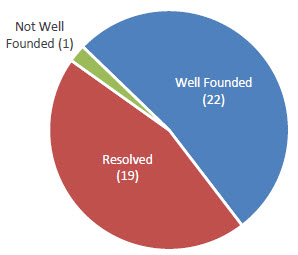
Long description
1 Not Well Founded
22 Well Founded
19 Resolved
6.2 Court Decisions
In FY 2021-22, there were no court proceedings actioned in respect of requests processed by National Defence.
7. Policies and procedures
7.1 Social Insurance Numbers
The Department of National Defence did not receive authority for new collection(s) or new consistent use(s) of Social Insurance Numbers during this reporting period.
8. Training and Awareness
8.1 ATIP training program
Departmental ATIP training continues to be provided on a virtual platform. Directorate training staff delivered the following training sessions to Defence employees and CAF members with specific emphasis on those staff with ATIP responsibilities:
- Introductory courses (ATIP 101 - General ATIP or Privacy Fundamentals, internal orientation for new staff, Privacy Protection);
- Advanced courses (ATIP 201 - Advanced ATIP or organization-specific content); and,
- ATIP awareness and engagement activities with the various branches and divisions.
8.2 Training and awareness activities
A total of 36 training sessions were delivered to approximately 1,576 individuals which represents a 5% decrease in individuals trained over the previous FY. This training was provided to Defence employees and CAF members on the administration of both the Access to Information Act and Privacy Act, as well as on appropriate management of personal information under the control of the institution. These virtual training sessions included ATIP 101, ATIP 201, Privacy Protection, and targeted training sessions for specific Defence organizations. Most training sessions were delivered by ATIP Directorate staff through video teleconference technologies, and some organizations conducted their own courses and sessions. An example of an organization conducting their own training sessions is the Canadian Forces Health Services group, which covered a variety of Privacy related topics.
In FY 2021-2022 the ATIP Directorate implemented a new employee orientation that provides an introduction to ATIP and the roles and responsibilities as an employee of the ATIP Directorate.
In keeping with promoting awareness, ATIP Directorate employees also provided guidance to third parties and requesters on the requirements of the Access to Information Act and the Privacy Act, Treasury Board (TB) policies and directives, and associated institutional procedures as required.
8.3 Employee well-being
The ATIP Directorate continues to place increased emphasis on directorate staff mental health, awareness and support. In addition to the ongoing ATIP operational training, a session on vicarious trauma training was provided to interested staff which focused on effective and practical strategies for managing indirect trauma exposure and completing the stress cycle in order to improve psychological health and safety.
9. Initiatives and projects
9.1 Technological Improvements
Shift to Paperless processing
The ongoing shift towards paperless processing of ATIP requests continued this FY. A review of the adoption of the electronic processes to reduce paper records determined that the majority of OPIs had switched over to electronic processes and are no longer providing paper records to the ATIP Directorate. Recent changes to this process have resulted in an improvement in OPI response times. The ATIP Directorate continues to use electronic signatures on letters to applicants and using Canada Post epost service to share records with applicants versus traditional mail has led to faster access to records for Canadians.
10. Monitoring compliance
To effectively monitor and report on ATIP performance in National Defence, the ATIP Directorate produces a monthly performance dashboard which tracks OPI record retrieval timeliness, overall ATIP compliance and key metrics such as privacy breach complaints. The ATIP dashboard is tabled monthly at senior level governance committee to ensure visibility on ATIP performance; it is proactively published on the Open Government portal and semi-annually on the DND website. In FY 2021-22, the Departmental ATIP Monthly Performance Dashboard continued to be refined and transitioned to MS Power BI. The new platform provides better usability and overall visibility to senior leadership on key metrics and overall ATIP performance. The monthly dashboard serves to track ATIP performance across the Department and identify organizations who may require assistance or training and to identify areas for process improvements. During this reporting period, information relating to the processing of Privacy Informal requests and the identification of errors in titles for briefing notes was added to the monthly dashboard.
The ATIP Directorate routinely responds to ad hoc requests for statistics and performance reports to inform program delivery and identify trends.
Currently, the time to process requests for correction of personal information is not formally monitored as this number is regularly very low. In FY 2021-22, the ATIP Directorate did not receive any requests for correction.
11. Privacy operating costs
11.1.1 Costs
The annual cost to administer the National Defence privacy program decreased by 14% to approximately $4,029,460 FY 2021-22.
11.1.2 Human Resources
During FY 2021-22, an equivalent of 44.020 full-time employees were dedicated to administering the Privacy Act. For additional information refer to section 11 in Annex B.
Annex A: Designation order
National Defence and the Canadian Armed Forces
Access to Information Act and Privacy Act Designation Order
- Pursuant to section 73 of the Access to Information Act and the Privacy Act, the Minister of National Defence, as the head of a government institution under these Acts, hereby designates the persons holding the following positions, or the persons occupying those positions on an acting basis, to exercise or perform all of the powers, duties and functions of the head of a government institution under these Acts:
- the Deputy Minister;
- the Corporate Secretary;
- the Director Access to Information and Privacy; and
- Deputy Directors Access to Information and Privacy.
- Pursuant to section 73 of the above-mentioned Acts, the Minister also designates the following:
- those persons holding the position of Access Team Leader, or the persons occupying this position on an acting basis, to exercise or perform the powers, duties and functions in respect of:
- The application of the following provisions under the Access to Information Act: section 9; subsection 11(2), 11(3), 11(4), 11(5), 11(6); sections 19, 20, 23 and 24; subsections 27(1) and 27(4); paragrap 28 (1)(b), subsections 28(2) and 28(4); and
- The response to requests made under the Access to Information Act if no records exist.
- those persons holding the position of Privacy Team Leader, or the persons occupying this position on an acting basis, to exercise or perform any of the powers, duties and functions of the head of an institution under the Privacy Act, other than under sub-paragraphs 8(2)(j) and 8(2)(m); and
- those persons holding the position of Privacy Senior Analyst, or the persons occupying this position on an acting basis, to exercise or perform the powers and duties in respect of the application of section 26 of the Privacy Act.
- those persons holding the position of Access Team Leader, or the persons occupying this position on an acting basis, to exercise or perform the powers, duties and functions in respect of:
Original signed by
The Honourable Harjit S. Sajjan, PC, OMM, MSM, CD, MP
Minister of National Defence
Date: 2016-01-12
Annex B: Statistical Report on the Privacy Act for 2021-2022
Statistical Report on the Privacy Act
Government of Canada
Statistical Report on the Privacy Act
Name of institution:
Department of National Defence
Reporting period:
2021-04-01 to 2022-03-31
Section 1: Requests Under the Privacy Act
1.1 Number of requests
| - | Number of Requests | |
|---|---|---|
| Received during reporting period | 6158 | |
| Outstanding from previous reporting period | 1224 | |
Outstanding from previous reporting period |
1154 | - |
Outstanding from more than one reporting period |
70 | |
| Total | 7382 | |
| Closed during reporting period | 6567 | |
| Carried over to next reporting period | 815 | |
Carried over within legislated timeline |
578 | - |
Carried over beyond legislated timeline |
237 | |
1.2 Channels of requests
| Source | Number of Requests |
|---|---|
| Online | 3772 |
| 486 | |
| 1900 | |
| In person | 0 |
| Phone | 0 |
| Fax | 0 |
| Total | 6158 |
Section 2: Informal requests
2.1 Number of informal requests
| - | Number of Requests | |
|---|---|---|
| Received during reporting period | 0 | |
| Outstanding from previous reporting period | 0 | |
Outstanding from previous reporting period |
0 | - |
Outstanding from more than one reporting period |
0 | |
| Total | 0 | |
| Closed during reporting period | 0 | |
| Carried over to next reporting period | 0 | |
2.2 Channels of informal requests
| Source | Number of Requests |
|---|---|
| Online | 0 |
| 0 | |
| 0 | |
| In person | 0 |
| Phone | 0 |
| Fax | 0 |
| Total | 0 |
2.3 Completion time of informal requests
| Completion Time | |||||||
|---|---|---|---|---|---|---|---|
| 1 to 15 days | 16 to 30 days | 31 to 60 days | 61 to 120 days | 121 to 180 days | 181 to 365 days | More than 365 days | Total |
| 0 | 0 | 0 | 0 | 0 | 0 | 0 | 0 |
2.4 Pages released informally
| Less Than 100 Pages Processed | 101-500 Pages Processed | 501-1,000 Pages Processed | 1,001-5,000 Pages Processed | More Than 5,000 Pages Processed | |||||
|---|---|---|---|---|---|---|---|---|---|
| Number of Requests | Pages Disclosed | Number of Requests | Pages Disclosed | Number of Requests | Pages Disclosed | Number of Requests | Pages Disclosed | Number of Requests | Pages Disclosed |
| 0 | 0 | 0 | 0 | 0 | 0 | 0 | 0 | 0 | 0 |
Section 3: Requests Closed During the Reporting Period
3.1 Disposition and completion time
| Disposition of requests | Completion time | |||||||
|---|---|---|---|---|---|---|---|---|
| 1 to 15 Days |
16 to 30 Days | 31 to 60 Days | 61 to 120 Days | 121 to 180 Days | 181 to 365 Days | More Than 365 Days | Total | |
| All disclosed | 316 | 702 | 134 | 63 | 29 | 21 | 5 | 1270 |
| Disclosed in part | 124 | 1614 | 725 | 343 | 258 | 250 | 116 | 3430 |
| All exempted | 25 | 20 | 4 | 3 | 0 | 0 | 1 | 53 |
| All excluded | 0 | 0 | 0 | 0 | 0 | 0 | 0 | 0 |
| No records exist | 1030 | 197 | 49 | 23 | 5 | 7 | 0 | 1311 |
| Request abandoned | 385 | 69 | 26 | 10 | 3 | 4 | 6 | 503 |
| Neither confirmed nor denied | 0 | 0 | 0 | 0 | 0 | 0 | 0 | 0 |
| Total | 1880 | 2602 | 938 | 442 | 295 | 282 | 128 | 6567 |
3.2 Exemptions
| Section | Number of Requests |
|---|---|
| 18(2) | 0 |
| 19(1)(a) | 3 |
| 19(1)(b) | 1 |
| 19(1)(c) | 36 |
| 19(1)(d) | 39 |
| 19(1)(e) | 0 |
| 19(1)(f) | 0 |
| 20 | 0 |
| 21 | 59 |
| 22(1)(a)(i) | 157 |
| 22(1)(a)(ii) | 0 |
| 22(1)(a)(iii) | 0 |
| 22(1)(b) | 32 |
| 22(1)(c) | 0 |
| 22(2) | 0 |
| 22.1 | 0 |
| 22.2 | 0 |
| 22.3 | 5 |
| 22.4 | 0 |
| 23(a) | 0 |
| 23(b) | 0 |
| 24(a) | 0 |
| 24(b) | 0 |
| 25 | 0 |
| 26 | 3408 |
| 27 | 141 |
| 27.1 | 0 |
| 28 | 1 |
3.3 Exclusions
| Section | Number of Requests |
|---|---|
| 69(1)(a) | 0 |
| 69(1)(b) | 0 |
| 69.1 | 0 |
| 70(1) | 0 |
| 70(1)(a) | 0 |
| 70(1)(b) | 0 |
| 70(1)(c) | 0 |
| 70(1)(d) | 0 |
| 70(1)(e) | 0 |
| 70(1)(f) | 0 |
| 70.1 | 0 |
3.4 Format of information released
| Paper | Electronic | Other | |||
|---|---|---|---|---|---|
| E-Record | Data set | Video | Audio | ||
| 326 | 4374 | 0 | 10 | 8 | 0 |
3.5 Complexity
3.5.1 Relevant pages processed and disclosed
| Number of Pages Processed | Number of Pages Disclosed | Number of Requests |
|---|---|---|
| 1579710 | 1527968 | 5256 |
3.5.2 Relevant pages processed and disclosed by size of requests
| Disposition | Less Than 100 Pages Processed | 101-500 Pages Processed | 501-1,000 Pages Processed | 1,001-5,000 Pages Processed | More Than 5,000 Pages Processed | |||||
|---|---|---|---|---|---|---|---|---|---|---|
| Number of Requests | Pages Disclosed | Number of Requests | Pages Disclosed | Number of Requests | Pages Disclosed | Number of Requests | Pages Disclosed | Number of Requests | Pages Disclosed | |
| All disclosed | 1019 | 17990 | 187 | 43821 | 53 | 35302 | 11 | 18630 | 0 | 0 |
| Disclosed in part | 1161 | 50057 | 1216 | 329261 | 613 | 441547 | 439 | 631245 | 1 | 6766 |
| All exempted | 51 | 331 | 2 | 406 | 0 | 0 | 0 | 0 | 0 | 0 |
| All excluded | 0 | 0 | 0 | 0 | 0 | 0 | 0 | 0 | 0 | 0 |
| Request abandoned | 494 | 155 | 6 | 1669 | 2 | 1391 | 1 | 1139 | 0 | 0 |
| Neither confirmed nor denied | 0 | 0 | 0 | 0 | 0 | 0 | 0 | 0 | 0 | 0 |
| Total | 2725 | 68533 | 1411 | 375157 | 668 | 478240 | 451 | 651014 | 1 | 6766 |
3.5.3 Relevant minutes processed and disclosed for audio formats
| Number of Minutes Processed | Number of Minutes Disclosed | Number of Requests |
|---|---|---|
| 1275 | 1002 | 8 |
3.5.4 Relevant pages processed and disclosed
| Disposition | Less than 60 Minutes processed | 60-120 Minutes processed | More than 120 Minutes processed | |||
|---|---|---|---|---|---|---|
| Number of Requests | Minutes Processed | Number of Requests | Minutes Processed | Number of Requests | Minutes Processed | |
| All disclosed | 0 | 0 | 0 | 0 | 0 | 0 |
| Disclosed in part | 5 | 194 | 1 | 60 | 2 | 1021 |
| All exempted | 0 | 0 | 0 | 0 | 0 | 0 |
| All excluded | 0 | 0 | 0 | 0 | 0 | 0 |
| Request abandoned | 0 | 0 | 0 | 0 | 0 | 0 |
| Neither confirmed nor denied | 0 | 0 | 0 | 0 | 0 | 0 |
| Total | 5 | 194 | 1 | 60 | 2 | 1021 |
3.5.5 Relevant minutes processed and disclosed for video formats
| Number of Minutes Processed | Number of Minutes Disclosed | Number of Requests |
|---|---|---|
| 1643 | 981 | 10 |
3.5.6 Relevant pages processed and disclosed by size of requests
| Disposition | Less than 60 Minutes processed | 60-120 Minutes processed | More than 120 Minutes processed | |||
|---|---|---|---|---|---|---|
| Number of Requests | Minutes Processed | Number of Requests | Minutes Processed | Number of Requests | Minutes Processed | |
| All disclosed | 0 | 0 | 1 | 60 | 0 | 0 |
| Disclosed in part | 3 | 105 | 1 | 64 | 5 | 1414 |
| All exempted | 0 | 0 | 0 | 0 | 0 | 0 |
| All excluded | 0 | 0 | 0 | 0 | 0 | 0 |
| Request abandoned | 0 | 0 | 0 | 0 | 0 | 0 |
| Neither confirmed nor denied | 0 | 0 | 0 | 0 | 0 | 0 |
| Total | 3 | 105 | 2 | 124 | 5 | 1414 |
3.5.7 Other complexities
| Disposition | Consultation Required | Assessment of Fees | Legal Advice Sought | Other | Total |
|---|---|---|---|---|---|
| All disclosed | 0 | 0 | 2 | 0 | 2 |
| Disclosed in part | 6 | 0 | 3 | 0 | 9 |
| All exempted | 0 | 1 | 0 | 0 | 1 |
| All excluded | 0 | 0 | 0 | 0 | 0 |
| Request abandoned | 0 | 1 | 0 | 0 | 1 |
| Neither confirmed nor denied | 0 | 0 | 0 | 0 | 0 |
| Total | 6 | 2 | 5 | 0 | 13 |
3.6 Closed requests
3.6.1 Number of requests closed within legislated timelines
| Number of requests closed within legislated timelines | 5308 |
| Percentage of requests closed within legislated timelines (%) | 80.83 |
3.7 Deemed refusals
3.7.1 Reasons for not meeting legislated timelines
| Number of Requests Closed Past the Legislated Timelines | Principal Reason | |||
|---|---|---|---|---|
| Interference with Operations / Workload | External consultation | Internal Consultation | Other | |
| 1259 | 725 | 0 | 0 | 534 |
3.7.2 Requests closed behond legislated timelines (including any extention taken)
| Number of Days Past Legislated Timelines | Number of Requests Past Legislated Timeline Where No Extension Was Taken | Number of Requests Past Legislated Timelines Where an Extension Was Taken | Total |
|---|---|---|---|
| 1 to 15 days | 63 | 31 | 94 |
| 16 to 30 days | 91 | 25 | 116 |
| 31 to 60 days | 175 | 51 | 226 |
| 61 to 120 days | 266 | 44 | 310 |
| 121 to 180 days | 181 | 9 | 190 |
| 181 to 365 days | 199 | 13 | 212 |
| More than 365 days | 111 | 0 | 111 |
| Total | 1086 | 173 | 1259 |
3.8 Requests for translation
| Translation Requests | Accepted | Refused | Total |
|---|---|---|---|
| English to French | 0 | 0 | 0 |
| French to English | 0 | 0 | 0 |
| Total | 0 | 0 | 0 |
Section 4: Disclosures Under Subsections 8(2) and 8(5)
| Paragraph 8(2)(e) | Paragraph 8(2)(m) | Subsection 8(5) | Total |
|---|---|---|---|
| 212 | 101 | 101 | 414 |
Section 5: Requests for Correction of Personal Information and Notations
| Disposition for Correction Requests Received | Number |
|---|---|
| Notations attached | 0 |
| Requests for correction accepted | 0 |
| Total | 0 |
Section 6: Extensions
6.1 Reasons for extensions
| Number of requests where an extension was taken | 15(a)(i) Interference with operations | 15 (a)(ii) Consultation | 15(b) Translation purposes or conversion | ||||||
|---|---|---|---|---|---|---|---|---|---|
| Further review required to determine exemptions | Large volume of pages | Large volume of requests | Documents are difficult to obtain | Cabinet Confidence Section (Section 70) | External | Internal | |||
| 993 | 0 | 0 | 993 | 0 | 0 | 0 | 0 | 0 | 0 |
6.2 Length of extensions
| Length of Extensions | 15(a)(i) Interference with operations | 15 (a)(ii) Consultation | 15(b) Translation purposes or conversion | ||||||
|---|---|---|---|---|---|---|---|---|---|
| Further review required to determine exemptions | Large volume of pages | Large volume of requests | Documents are difficult to obtain | Cabinet Confidence Section (Section 70) | External | Internal | |||
| 1 to 15 days | 0 | 0 | 0 | 0 | 0 | 0 | 0 | 0 | 0 |
| 16 to 30 days | 0 | 0 | 993 | 0 | 0 | 0 | 0 | 0 | 0 |
| 31 days or greater | 0 | 0 | 0 | 0 | 0 | 0 | 0 | 0 | 0 |
| Total | 0 | 0 | 993 | 0 | 0 | 0 | 0 | 0 | 0 |
Section 7: Consultations Received From Other Institutions and Organizations
7.1 Consultations received from other Government of Canada institutions and other organizations
| Consultations | Other Government of Canada Institutions | Number of Pages to Review | Other Organizations | Number of Pages to Review |
|---|---|---|---|---|
| Received during reporting period | 5 | 3466 | 0 | 0 |
| Outstanding from the previous reporting period | 1 | 77 | 0 | 0 |
| Total | 6 | 3543 | 0 | 0 |
| Closed during the reporting period | 6 | 3543 | 0 | 0 |
| Carried over within negotiated timelines | 0 | 0 | 0 | 0 |
| Carried over beyond negotiated timelines | 0 | 0 | 0 | 0 |
7.2 Recommendations and completion time for consultations received from other Government of Canada institutions
| Recommendations | Number of Days Required to Complete Consultation Requests | |||||||
|---|---|---|---|---|---|---|---|---|
| 1 to 15 Days | 16 to 30 Days | 31 to 60 Days | 61 to 120 Days | 121 to 180 Days | 181 to 365 Days | More Than 365 Days | Total | |
| All disclosed | 2 | 0 | 0 | 0 | 0 | 0 | 1 | 3 |
| Disclosed in part | 2 | 0 | 0 | 1 | 0 | 0 | 0 | 3 |
| All exempted | 0 | 0 | 0 | 0 | 0 | 0 | 0 | 0 |
| All excluded | 0 | 0 | 0 | 0 | 0 | 0 | 0 | 0 |
| Consult other institution | 0 | 0 | 0 | 0 | 0 | 0 | 0 | 0 |
| Other | 0 | 0 | 0 | 0 | 0 | 0 | 0 | 0 |
| Total | 4 | 0 | 0 | 1 | 0 | 0 | 1 | 6 |
7.3 Recommendations and completion time for consultations received from other organizations
| Recommendations | Number of Days Required to Complete Consultation Requests | |||||||
|---|---|---|---|---|---|---|---|---|
| 1 to 15 Days | 16 to 30 Days | 31 to 60 Days | 61 to 120 Days | 121 to 180 Days | 181 to 365 Days | More Than 365 Days | Total | |
| All disclosed | 0 | 0 | 0 | 0 | 0 | 0 | 0 | 0 |
| Disclosed in part | 0 | 0 | 0 | 0 | 0 | 0 | 0 | 0 |
| All exempted | 0 | 0 | 0 | 0 | 0 | 0 | 0 | 0 |
| All excluded | 0 | 0 | 0 | 0 | 0 | 0 | 0 | 0 |
| Consult other institution | 0 | 0 | 0 | 0 | 0 | 0 | 0 | 0 |
| Other | 0 | 0 | 0 | 0 | 0 | 0 | 0 | 0 |
| Total | 0 | 0 | 0 | 0 | 0 | 0 | 0 | 0 |
Section 8: Completion Time of Consultations on Cabinet Confidences
8.1 Requests with Legal Services
| Number of Days | Fewer Than 100 Pages Processed | 101-500 Pages Processed | 501-1000 Pages Processed | 1001-5000 Pages Processed | More Than 5000 Pages Processed | |||||
|---|---|---|---|---|---|---|---|---|---|---|
| Number of Requests | Pages Disclosed | Number of Requests | Pages Disclosed | Number of Requests | Pages Disclosed | Number of Requests | Pages Disclosed | Number of Requests | Pages Disclosed | |
| 1 to 15 | 0 | 0 | 0 | 0 | 0 | 0 | 0 | 0 | 0 | 0 |
| 16 to 30 | 0 | 0 | 0 | 0 | 0 | 0 | 0 | 0 | 0 | 0 |
| 31 to 60 | 0 | 0 | 0 | 0 | 0 | 0 | 0 | 0 | 0 | 0 |
| 61 to 120 | 0 | 0 | 0 | 0 | 0 | 0 | 0 | 0 | 0 | 0 |
| 121 to 180 | 0 | 0 | 0 | 0 | 0 | 0 | 0 | 0 | 0 | 0 |
| 181 to 365 | 0 | 0 | 0 | 0 | 0 | 0 | 0 | 0 | 0 | 0 |
| More than 365 | 0 | 0 | 0 | 0 | 0 | 0 | 0 | 0 | 0 | 0 |
| Total | 0 | 0 | 0 | 0 | 0 | 0 | 0 | 0 | 0 | 0 |
8.2 Requests with Privy Council Office
| Number of Days | Fewer Than 100 Pages Processed | 101-500 Pages Processed | 501-1000 Pages Processed | 1001-5,000 Pages Processed | More Than 5000 Pages Processed | |||||
|---|---|---|---|---|---|---|---|---|---|---|
| Number of Requests | Pages Disclosed | Number of Requests | Pages Disclosed | Number of Requests | Pages Disclosed | Number of Requests | Pages Disclosed | Number of Requests | Pages Disclosed | |
| 1 to 15 | 0 | 0 | 0 | 0 | 0 | 0 | 0 | 0 | 0 | 0 |
| 16 to 30 | 0 | 0 | 0 | 0 | 0 | 0 | 0 | 0 | 0 | 0 |
| 31 to 60 | 0 | 0 | 0 | 0 | 0 | 0 | 0 | 0 | 0 | 0 |
| 61 to 120 | 0 | 0 | 0 | 0 | 0 | 0 | 0 | 0 | 0 | 0 |
| 121 to 180 | 0 | 0 | 0 | 0 | 0 | 0 | 0 | 0 | 0 | 0 |
| 181 to 365 | 0 | 0 | 0 | 0 | 0 | 0 | 0 | 0 | 0 | 0 |
| More than 365 | 0 | 0 | 0 | 0 | 0 | 0 | 0 | 0 | 0 | 0 |
| Total | 0 | 0 | 0 | 0 | 0 | 0 | 0 | 0 | 0 | 0 |
Section 9: Complaints and Investigations Notices Received
| Section 31 | Subsection 33 | Section 35 | Court action | Total |
|---|---|---|---|---|
| 54 | 40 | 22 | 0 | 116 |
Section 10: Privacy Impact Assessments (PIAs) and Personal Information Banks (PIBs)
10.1 Privacy Impact Assessments
| Number of PIAs completed | 5 |
| Number of PIAs modified | 0 |
10.2 Personal Information Banks
| Personal Information Banks | Active | Created | Terminated | Modified |
|---|---|---|---|---|
| Institution-specific | 58 | 2 | 0 | 5 |
| Central | 0 | 0 | 0 | 0 |
| Total | 58 | 2 | 0 | 5 |
Section 11 – Privacy Breaches
11.1 Material Privacy Breaches reported
| Number of material privacy breaches reported to TBS | 0 |
| Number of material privacy breaches reported to OPC | 0 |
11.2 Non-Material Privacy Breaches
| Number of non-material privacy breaches | 185 |
Section 12: Resources Related to the Privacy Act
12.1 Allocated Costs
| Expenditures | Amount | |
|---|---|---|
| Salaries | $3,019,767 | |
| Overtime | $7,817 | |
| Goods and Services | $1,001,876 | |
|
$479,126 | - |
|
$522,750 | |
| Total | $4,029,460 | |
12.2 Human Resources
| Resources | Person Years Dedicated to Privacy Activities |
|---|---|
| Full-time employees | 38.020 |
| Part-time and casual employees | 3.000 |
| Regional staff | 0.000 |
| Consultants and agency personnel | 3.000 |
| Students | 0.000 |
| Total | 44.020 |
Note: Enter values to three decimal places
Annex C: Supplemental Statistical Report on the Access to Information Act and Privacy Act for 2021-2022
Supplemental Statistical Report on the Access to Information Act and Privacy Act
Name of institution:
Department of National Defence
Reporting period:
2021-04-01 to 2022-03-31
Section 1: Capacity to Receive Requests
Enter the number of weeks your institution was able to receive ATIP requests through the different channels.
| - | Number of Weeks |
|---|---|
| Able to receive requests by mail | 52 |
| Able to receive requests by email | 52 |
| Able to receive requests through the digital request service | 52 |
Section 2: Capacity to Process Records
2.1 Enter the number of weeks your institution was able to process paper records in different classification levels.
| - | No Capacity | Partial Capacity | Full Capacity | Total |
|---|---|---|---|---|
| Unclassified Paper Records | 0 | 0 | 52 | 52 |
| Protected B Paper Records | 0 | 0 | 52 | 52 |
| Secret and Top Secret Paper Records | 0 | 0 | 52 | 52 |
2.2 Enter the number of weeks your institution was able to process electronic records in different classification levels.
| - | No Capacity | Partial Capacity | Full Capacity | Total |
|---|---|---|---|---|
| Unclassified Paper Records | 0 | 0 | 52 | 52 |
| Protected B Paper Records | 0 | 0 | 52 | 52 |
| Secret and Top Secret Paper Records | 0 | 0 | 52 | 52 |
Section 3: Open Requests and Complaints Under the Access to Information Act
3.1 Enter the number of open requests that are outstanding from previous reporting periods.
| Fiscal Year Open Requests Were Received | Open Requests that are Within Legislated Timelines as of March 31, 2022 | Open Requests that are Beyond Legislated Timelines as of March 31, 2022 | Total |
|---|---|---|---|
| Received in 2021-2022 | 224 | 608 | 832 |
| Received in 2020-2021 | 4 | 411 | 415 |
| Received in 2019-2020 | 1 | 281 | 282 |
| Received in 2018-2019 | 2 | 137 | 139 |
| Received in 2017-2018 | 1 | 50 | 51 |
| Received in 2016-2017 | 0 | 44 | 44 |
| Received in 2015-2016 or earlier | 0 | 15 | 15 |
| Total | 232 | 1546 | 1778 |
3.2 Enter the number of open complaints with the Information Commissioner of Canada that are outstanding from previous reporting periods.
| Fiscal Year Open Complaints Were Received by Institution | Number of Open Complaints |
|---|---|
| Received in 2021-2022 | 34 |
| Received in 2020-2021 | 24 |
| Received in 2019-2020 | 36 |
| Received in 2018-2019 | 8 |
| Received in 2017-2018 | 4 |
| Received in 2016-2017 | 1 |
| Received in 2015-2016 or earlier | 8 |
| Total | 115 |
Section 4: Open Requests and Complaints Under the Privacy Act
4.1 Enter the number of open requests that are outstanding from previous reporting periods.
| Fiscal Year Open Requests Were Received | Open Requests that are Within Legislated Timelines as of March 31, 2022 | Open Requests that are Beyond Legislated Timelines as of March 31, 2022 | Total |
|---|---|---|---|
| Received in 2021-2022 | 578 | 166 | 744 |
| Received in 2020-2021 | 0 | 61 | 61 |
| Received in 2019-2020 | 0 | 9 | 9 |
| Received in 2018-2019 | 0 | 1 | 1 |
| Received in 2017-2018 | 0 | 0 | 0 |
| Received in 2016-2017 | 0 | 0 | 0 |
| Received in 2015-2016 or earlier | 0 | 0 | 0 |
| Total | 578 | 237 | 815 |
4.2 Enter the number of open complaints with the Privacy Commissioner of Canada that are outstanding from previous reporting periods.
| Fiscal Year Open Complaints Were Received by Institution | Number of Open Complaints |
|---|---|
| Received in 2021-2022 | 25 |
| Received in 2020-2021 | 6 |
| Received in 2019-2020 | 2 |
| Received in 2018-2019 | 1 |
| Received in 2017-2018 | 0 |
| Received in 2016-2017 | 0 |
| Received in 2015-2016 or earlier | 0 |
| Total | 34 |
Section 5: Social Insurance Number (SIN)
| Did your institution receive authority for a new collection or new consistent use of the SIN in 2021-2022? | No |
